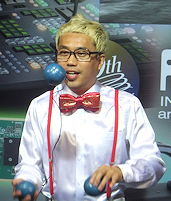At the Korea annual broadcast exhibition and conference, KOBA, 3DTV production equipment and techniques took centre stage.
| One of the demonstrations showed 3D material shot live at 700 pictures per second replayed in 3D at normal 60Hz picture rates. For the type of content shown in the demonstrations (fighting and juggling) the 3D pictures have considerable impact.
One manufacturer (Sony) offered a range of two 3DTV production cameras. The larger and more expensive XDCAM camcorder includes dual 3-chip 1/2 inch 1080p CMOS sensors. It can be switched from 3D to 2D modes. Interocular spacing can be manually adjusted so depth position can be adjusted on recording. Their other camera was a smaller and upgraded version of the company's consumer handheld 3D camera, which has 1/4 inch sensors.
Another manufacture (RedRover) showed 3D reference monitors. The performance was achieved by using two flat panels mounted at right angles to each other, each with opposite polarisation filters, and which are combined to view via a 45 degree semi-silvered mirror. |  |
While good quality monitoring can be done, because the stereo window lies set back from monitor front plane, the appearance of the 3D picture is rather as a 'puppet theatre' with the reference monitor sized screen shown. This approach to 3DTV monitoring, though using 2 CRT monitors, was, incidentally, part of the work in the EBU for the first 3DTV broadcasts in 1982.
